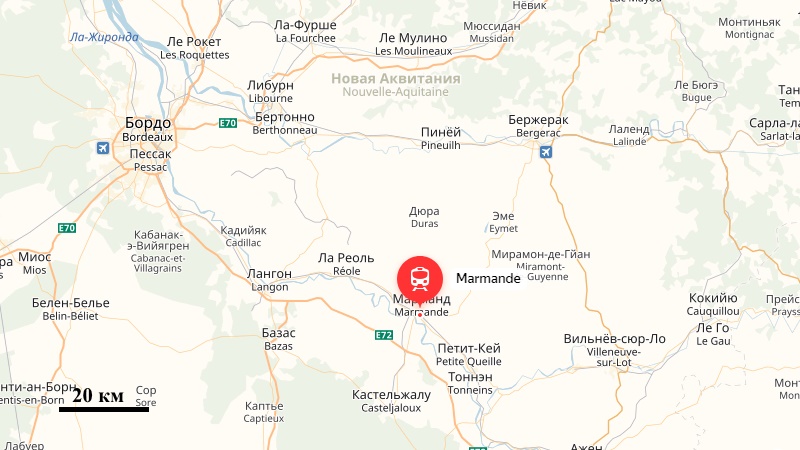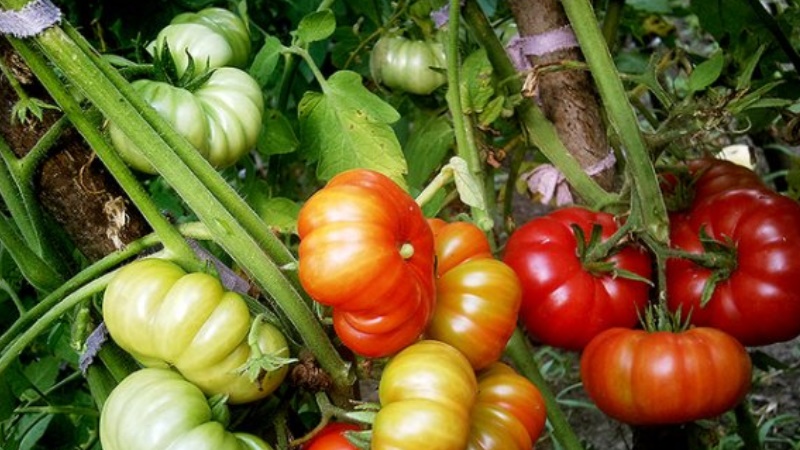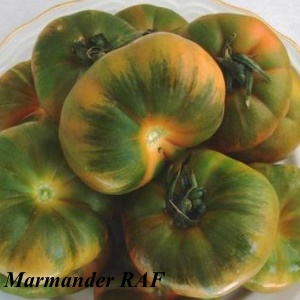A miracle of Dutch selection - tomato "Marmande": what is good and how to grow it on your site
The Marmande tomato was bred by the French company Vilmorin Seed and first went on sale in 1897. The variety was named after the French city of Marmande. In this area, until the 60s of the XIX century, they were engaged in viticulture, but the grape phylloxera, or grape aphid, imported from the USA, destroyed the vineyards. Farmers began to grow tomatoes instead of grapes.
We will use their experience and tell you how to grow a French tomato in a Russian country house.
The content of the article
- Characteristics and description of the variety
- How to grow seedlings
- How to grow tomatoes
- Features of cultivation and possible difficulties
- Diseases and pests
- The nuances of growing in open ground and in a greenhouse
- Harvesting and application of the crop
- Advantages and disadvantages of the variety
- Farmers reviews
- Conclusion
Characteristics and description of the variety
Marmande has been one of the most popular in Europe for over a hundred years. What qualities allowed the tomato to gain such fame?
Super Marmande subspecies
With the growing popularity, tomato seeds began to be produced in Germany, the Netherlands, Spain, the United States and other countries of the world.
Breeders in many countries have worked to adapt the French variety to growing conditions. So, in Spain, the Marmande RAF (resistente a Fusarium) variety appeared, which means "Fusarium-resistant Marmande." French breeders decided to "decorate" the old Marmande and brought out the unusually bright Marmande Montpellier.
Breeders in the Netherlands have recreated and improved the variety, calling it Super Marmande. On the Russian market, you can find this and the classic name of Marmande.

Distinctive features
This variety is early ripe (75-100 days), semi-determinant (140-180 cm), salad with a classic sweet and sour taste. It is unpretentious in maintenance, grows well on any soil, both in open and closed ground.
Strong, strong and compact bushes are moderately frost-resistant and resistant to fusarium, verticillosis and a number of other diseases.
Fruit characteristics, yield
Fruits are tied in clusters of 4-6 pieces. They are flat-rounded, ribbed, weighing 150-250 g.
The photo clearly shows that the fruits are especially ribbed at the stalk. The pulp of the fruit is fleshy, oily, with four chambers. The purpose of the fruits is universal, but it is better to eat everything fresh. Productivity - 9-10 kg per 1 sq. m.

How to grow seedlings
Strong seedlings are the key to a rich harvest. How to grow a good seedlings?
Seed preparation
Good seedling starts with seed preparation. Remember that pre-treatment disinfects seeds and accelerates their germination.
A well-known collector of rare and exotic varieties of tomatoes, a tomato expert who has tested 1,300 varieties of tomatoes, Lyudmila Kodzasova advises to process tomato seeds with 40 ° vodka: “vodka awakens, accelerates and disinfects”. She recommends pouring vodka on the seeds for 15-20 minutes, then rinsing them with water and planting.
The Belarusian scientist Ivan Russkikh recommends treating the seeds with undiluted brilliant green or chlorhexidine from a pharmacy. Treatment time 30 minutes, rinse thoroughly and plant.
Capacity and soil
As containers for growing seedlings, cups from sour cream, mayonnaise, beer, etc. are suitable. Holes must be made in containers.
Important! The depth of the containers for growing plants must be at least 10 cm for roots to develop.
It is not difficult to buy soil or substrate in a store or collect it under birches in the fall.
Before pouring the substrate into the planting container, large shells of eggs or walnuts are poured into them as drainage. The containers are filled with a substrate, not reaching a few centimeters to the edge. Then the earth is tamped and spilled with boiling water with a solution of pink potassium permanganate.
Sowing
When planting, pay attention to the timing of fruit ripening and estimate when you are going to harvest. Please note that tomatoes need 10 days to germinate. If you are not going to use supplementary lighting, then it is better to sow in early March.
The seeds are carefully laid out on the prepared substrate and covered with a centimeter layer of soil on top, moistening the soil with water from a sprayer. Cover with a lid or a plastic bag until sprouts appear.
As soon as the "loops" appeared, remove the covers, packages and place containers with seedlings on the window.
Growing and care
When the second true leaves appear on the seedlings, a pick is made. With a knife or stick, gently prying the root together with the earth.
Important! Before picking, the seedlings are well watered.
Plants are planted in moist soil, deeply deepening, up to the cotyledons. You cannot water from above.
After transplanting, the seedlings are shaded for several days. When the first watering comes, it is advisable to water the plants with a solution of baker's yeast (a pack of baker's yeast, 1 cup of sifted ash, 1/2 cup of sugar, 3 liters of water). The baker's yeast mixture is prepared in 3-4 days, as it should be infused.
Seedlings respond well to watering with a mineral water solution: a glass for 1 liter of water.
How to grow tomatoes
Marmande is distinguished by its unpretentious care - the harvest is obtained even on the scantiest, lifeless soils. However, the better the conditions and care, the richer and tastier the harvest!
Landing
 Before planting, first of all, they prepare the greenhouse: they wash the walls, burn the threads, the ropes to which the tomatoes were tied.
Before planting, first of all, they prepare the greenhouse: they wash the walls, burn the threads, the ropes to which the tomatoes were tied.
The soil in the greenhouse is dug up, freeing from the roots of previous plants, and two weeks before planting seedlings spill "Fitosporin", a week - with a solution boric acid (1 tablespoon for 10 liters of water).
Planting seedlings in the ground is carried out in the established warm weather. If you want to plant earlier, you need shelter. Tomatoes are planted at a distance of 0.5 m from each other and 0.4 m between rows, not closer.
Before planting, prepare holes, where they put ½ buckets of humus (rotted two to three year old horse manure), which is poured with a solution of raspberry-colored potassium permanganate, and then a tablespoon of potassium sulfate, a tablespoon of superphosphate, ½ cup of ash, a tablespoon of fish meal are added and everything is mixed.
A plant is placed in the finished hole at an angle of 45 degrees, orienting it from north to south, covered with earth, tamped, watered (1 liter of water).
After 10 days, the plants are watered with a solution, which is prepared from 100 g of yeast and 10 liters of water so that the tomatoes grow well and do not stretch out.
Care
The most important rules of care:
- Plants are not watered often - about once a week (1 liter of water under a bush).
- To make the tomatoes set well, the seedlings are watered with potassium sulfate (1 tablespoon per 10 liters of water).
- Tomato plants also love foliar feeding with iodine, manganese, boric acid, "Epin", "Zircon". Spraying is carried out every 10 days.
- During the heat, it is imperative to spray the tomatoes with boric acid.
- When the third brush blooms, pour it over with calcium: 1 tablespoon per 10 liters. water.
- During the season, ash is poured several times.
- The soil around the plants is mulched with a layer of 8 cm and watered with "Fitosporin".
- The lower leaves are cut off.
About the formation of tomato bushes:
Features of cultivation and possible difficulties
Regular, moderate watering (excess moisture leads to the destruction of the root system).
To prevent the fruits from cracking, make sure that the soil is moistened evenly. How can this be achieved? First of all mulching soil. Mulching protects against overheating and moisture stays in the soil longer.
If, nevertheless, the soil is very dry, then watering the bushes is carried out repeatedly with interruptions, without flooding. Watering is carried out with warm settled water directly under the bush, no more than 1 liter.
During the ripening of the fruits, watering is minimal.
Diseases and pests
The Marmande tomato variety is distinguished by persistent immunity to diseases and pests, but for prevention it is necessary to carry out processing:
- spray with "Fitosporin";
- mulch the soil;
- pick off the lower leaves.
The nuances of growing in open ground and in a greenhouse
 When choosing a site for growing, please note that the soil on which other nightshades (eggplants, peppers) grew is not suitable for growing tomatoes.
When choosing a site for growing, please note that the soil on which other nightshades (eggplants, peppers) grew is not suitable for growing tomatoes.
When planting tomatoes, compost, peat or rotted manure are added to the planting holes (fresh manure burns plant roots).
Planting density - no more than 5 plants per 1 sq. m. Water warm settled water.
Despite the fact that the bushes of this variety are compact, they must be tied up, since the branches can break under the weight of the harvest.
Tomato varieties Marmande must be pinned for the entire growing season. The best yield is achieved when the bush is formed into two or three stems.
During extreme heat, tomato flowers in the greenhouse become sterile, therefore, it is necessary to lower the temperature in the greenhouse: close the top of the greenhouse with lutrasil so that the sun does not burn, open the doors and windows.
Harvesting and application of the crop
The first fruits are harvested within 75-100 days after seed germination. The variety is early maturing. Since the fruits are dense, strong, they perfectly tolerate transportation, are stable, have an attractive presentation, therefore they are good for industrial cultivation.
The fruits of the variety are sweetish-sour, have a universal purpose. The best application is processing into tomato juice. Lovers of tomato jam like this variety. In France, it is stuffed with soft cheese and baked in the oven.
Delicious recipe:
Advantages and disadvantages of the variety
 The advantages of tomato Marmande include:
The advantages of tomato Marmande include:
- traditional, classic sweet and sour tomato flavor;
- aroma;
- attractive appearance;
- easy to transport;
- long-term preservation of fruits;
- early maturity;
- undemanding care;
- resistance to many diseases and pests;
- yield;
- it is not a hybrid that allows you to collect seeds yourself.
The disadvantages of the variety include the need for dressing and garters.
Farmers reviews
Vegetable growers call Marmande a good find. Tomatoes are used fresh and conservation... According to summer residents, this is the best variety for making tomato juice - it turns out thick and moderately sweet. Some people complain about the uneven maturation. Large fruits, in their opinion, ripen only at the bottom, and the upper brushes do not have time to keep up with frost.
Renowned tomato collector Valentina Rarely writes: “The French handsome Super Marmande has earned a lot of positive reviews among Russian farmers. Everything is perfect in it - taste, size, and cultivation features. "
 Private collector Anna, Moscow: “Not a bad tomato, even if you want to grow it for sale. The fruits are firm and firm, do not crack and are well preserved. During the growing period, regular fertilizing with fertilizers is important, and basic agricultural practices are also required. "
Private collector Anna, Moscow: “Not a bad tomato, even if you want to grow it for sale. The fruits are firm and firm, do not crack and are well preserved. During the growing period, regular fertilizing with fertilizers is important, and basic agricultural practices are also required. "
Zhanna, Moscow region: “Bushes 70-80 cm high. Delicious sweet tomatoes 100-150 g each. Productivity is above average. Extended fruiting. Above average, they are affected by late blight. "
Silva, Moscow region: “I have been dealing with tomatoes for a long time, I grow both varieties and hybrids. Among the undersized tomatoes, my favorite is Marmande. The harvest is excellent every year. The fruits are large, very tasty. It is from them that I make the very first salads. I harvest until autumn, as the brushes ripen gradually. I advise you to plant at least 2-3 bushes. "
Vladimir, Far East: “I don’t deal with the garden, I buy tomatoes from my neighbor in the country. Once I saw the fruit of an unusual shape. They were Marmande tomatoes. Took it for trial. Now I buy them every year. Delicious, sweet, meaty. Salads made from them are simply delicious. "
Conclusion
Growing a French relic in your garden is not so difficult. In order for the harvest to please you, in central Russia you will have to work hard, since even the most unpretentious variety requires a lot of sun and heat. Watering is necessary every week. Feed throughout the entire growth period. You will be rewarded with dense, bright fruits with a classic taste and good keeping quality.
Interesting video about tomato Marmanda: